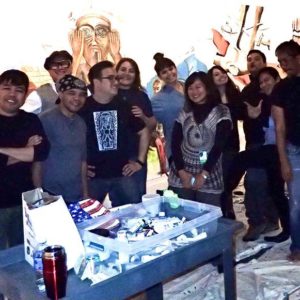Quezon City Chronicles: Spaces

I am back in Manila for my second trip from Chicago this year. I am celebrating the holidays with my parents and two siblings. This was supposedly the year for my children to spend Christmas with their father, so I took the chance to celebrate Christmas with my parents, sister, and brother visiting from Canada. I did not know at the time I booked my flight months ago that my children had no plans to visit their father and that my son, bereft of his girlfriend who would be traveling, might spend Christmas alone in San Francisco. I urged him to see his sister in Chicago but by the time he got around to checking flights, the prices were ridiculous.
Christmas alone. Growing up in a Filipino household, those two words are as frightening as the ghosts of Christmas in A Christmas Carol by Charles Dickens. The phrase conjures up images of eating Noche Buena alone, occupying space-for-one in the pew during Christmas Eve Mass, staring at presents (hopefully there were some) already received or waiting to be given. The downside of the gregarious hospitality of Filipinos is that when there is nobody to be hospitable to, we feel an extraordinary emptiness. There is no opportunity for indulgence or generosity. The parol is lit up in front of a door that remains closed.
Manny Garibay, an acclaimed Filipino painter who is deeply introspective, has asked what makes Philippine art Filipino. Does our visual art have unique characteristics easily identifiable as our own? What is peculiar about our use of color, line, form, or subject matter that makes it distinct from the art of other nationalities? After a long period of researching that question, my answer is that Filipinos are intimidated by space. Our painters fill up every inch of their canvas, sparing not even an inch of white. Negative space is space wasted. And why this aesthetic? I think this expression of profundity is the result of our natural environment. Every inch of our tropical forests grows life. Our bodies of water, serene on the surface, teems with motion underneath, that comes from being one of the most biodiverse ecosystems on the Planet. We exist in abundance. Even cracks in our urban landscapes of cement and plaster sprouts intrepid tendrils of green. We do not waste, not even air. Philippine shopping malls layer music on top of the ambient noise of shopping. Sometimes we find it difficult to hear, speak, and breathe.
But physically, emotionally, cognitively, we need space. In our dense rainforests, slivers of sunlight reach orchids and ferns growing under the canopy cover of trees. On a cellular level, there is lacuna in tissue, for air. Sea turtles need to navigate currents of water, not plastic. Paragraphs are separated by indentation. Our art—yes, my dear painter friends, I will say it—occasionally needs emptiness as context. Negative space can enhance an object. It helps us to see the real subject, by interlocking what it is and what it is not.
Spending Christmas alone need not be the pitiful, depressing situation that most Filipinos dread. It is not just the time to be with family, but also the time to ponder what family is. Sometimes, that is best contemplated in its absence. Having lived apart from my parents for most of my adult life, I am more aware of their presence. A few years ago, I spent Christmas without family. There was no reason to bake my traditional hazelnut shortbread cookies dipped in chocolate, no Swedish cinnamon ring for Christmas morning. No navigating grocery store aisles. No mess. And silence that I could fill with whatever sound I wanted. It was hard but my endurance—and capacity for forgiveness—was a revelation. (Thank you, by the way, to my dear friends who treated me like family. And to one friend whose nonchalant, “Christmas (or replace with any holiday) is just one day.” That was unexpectedly comforting.)
I am hoping that my two children, who may not be spending Christmas with a biological family member December 25th, will realize that family is more than whom you spend time with. Family is what you do for each other, even when separated by physical distance. It is faith in each other that, no matter how many holidays are not shared, the next gathering will be cherished.
But if anybody knows of a decent SFO-ORD-SFO airfare around Christmas, hit me up.
“Deconstructing Filipino” is a collaborative work produced by five Filipino American artists (left) and five Filipino artists (right) for Art and Anthropology: Portrait of the Object as Filipino. This cross-national art project was funded by the John D. and Catherine T. MacArthur Foundation, with support from the Field Museum in Chicago. The 8’x20’ painting illustrates the difference in the use of space by both groups. The Filipino artists continued to add objects until I told them they had to stop to retain balance in the entire work. The historic painting was on exhibit at the Field Museum from 2015-2017, after which it was donated to the Filipino American National Historical Society, Midwest Chapter.
ABOVE PHOTO:
Filipino American artists: Elisha Boughner, Jen Buckler, Cesar Conde, Joel Javier, Trisha Oralie Martin
Filipino artists: Leonardo Aguinaldo, Emmanuel “Manny” Garibay, Florentino “Jun” Impas Jr., Jason Moss, Othoniel “Otto” Neri




Leave a Reply